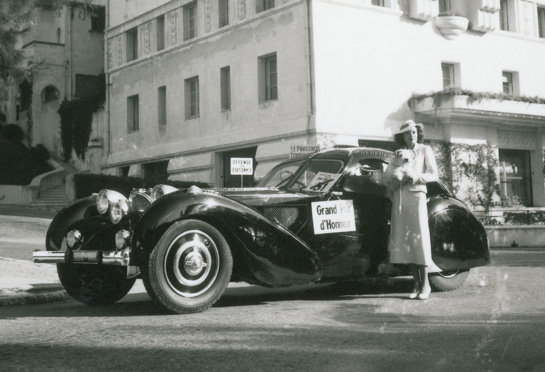
Madam Holtzschuch poses with the T57S in its first iteration at the Juan de Pins Concours on Cap d'Antibes in 1937. Credit: Pierre-Yves Laugier Collection.
By Michael T. Lynch
Much of the breathless reportage in the business and popular press of the recent sale of a Type 57SC Bugatti Atlantic focused on its price and the supposed fact that there were only two — some said three — Atlantics built.
There were actually four cars.
An “Aérolithe” prototype was constructed as a show car without accoutrements such as windshield wipers and other details. The Aérolithe T57 57331, was first displayed at the 1935 Paris Salon where it was a star of the show.
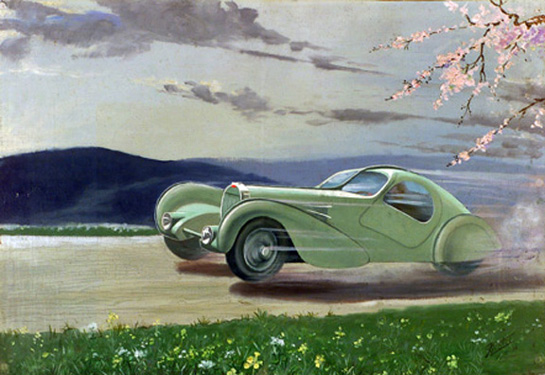
This is a rendering of the original Aérolithe coupe displayed at the 1935 Paris Salon. No color pictures exist but this may reflect the color, as Jean Bugatti referred to the project as Crème de Menthe.
The first production version of what we call an Atlantic was T57 57374 now in the Mullin Automotive Museum, an Aéro coupe. It won Best of Show at Pebble Beach in 2003. The second, 57453/57454 was also an Aéro. It has been missing for well over half a century. In the course of its life, the serial number was changed by one digit. It was on a list of cars to be shipped to Bordeaux in 1941. Whether it arrived or not, we do not know. The third car, 57473, was called an Atlantic. It was so named after the failure of a 1936 French airmail flight that went down in the south Atlantic and took the life of famed aviator, Jean Mermoz and his crew. The final car was 57591, the 1990 Pebble Beach-winning Atlantic owned by Ralph Lauren.
Please take the time to contribute and keep VeloceToday coming to your inbox every week. It’s easy and safe. Simply click here for details.
Those fortunate enough to spend the day on the lawn at the Pebble Beach Concours d’Elegance this year will be able to enjoy the third car (57473) now owned by a Spanish industrialist who has a Bugatti Royale among his other Molsheim creations.
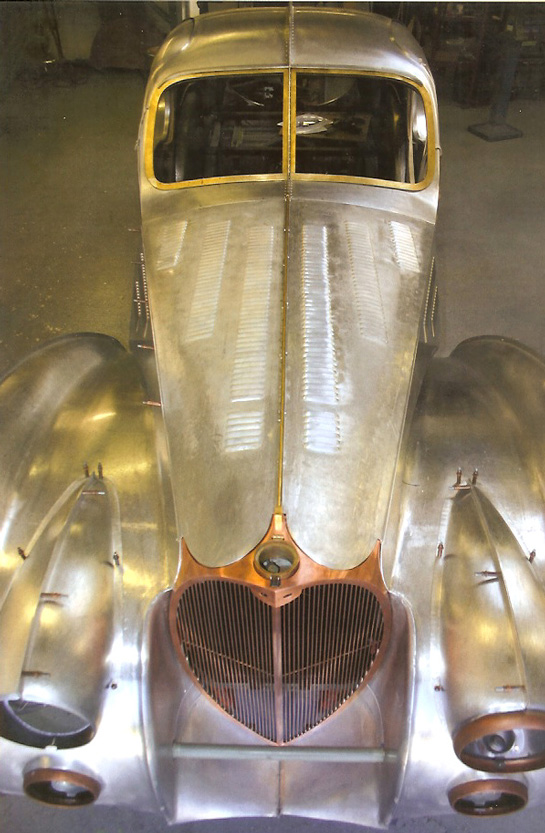
The Atlantic in Paul Russell's atelier. Notice the use of brass for framing and surrounds. Credit: Paul Russell
The third car was delivered to Jacques and Yvonne Holtzschuch late in 1936. In 1937, the Holtzschuchs entered the car in a concours at the French resort of Juan les Pins, where a photo was taken of Madam Holtzschuch standing with the car. It was black with a beige pigskin interior. The next photos that provide important history were taken when the Bugatti appeared in a race at Nice in 1951, now in French racing blue. The car had not only been repainted, but restyled as well, inside and out.
The noted auto historian, Christian Huet, has opined that the styling changes were made by none other than the firm of Figoni and Falaschi of Paris, perhaps the most famous French coachbuilder of the 1930s. His conclusions were based on the sun ray wood pattern in the door cappings, similar to those see on Figoni and Falaschi Talbot-Lagos. The seats were also in the Figoni style. The dash was metal rather than the expected Bugatti wood. While no job sheet exists in the Figoni records, these were not kept on work that involved customizing, as opposed to complete coachwork for a bare chassis. This type of task was not uncommon for Figoni who was running a body shop performing a full gamut of services from fixing dents to creating some of the most stunning shapes in the history of automobiles.
After passing through several owners, the car was purchased by René Chatard, the owner of a well-known Paris women’s boutique named Fashionable. Already the owner of three Bugattis, Chatard registered this one in the name of his mistress, Mademoiselle Marguerite Schneider, perhaps to hide its existence from his wife and daughter. By the turn of the year 1955, it had been painted grey. On August 22nd of that year, Chatard was travelling on the D44 near Gien in central France at 22:45 Hours with a young woman named Jeanine Vacheron. The Bugatti was struck by a train, and both perished. This led to a decade-long lawsuit, the residual of which was that the car was awarded to Mlle. Schneider. She sold it almost immediately to a junkyard in Gien.
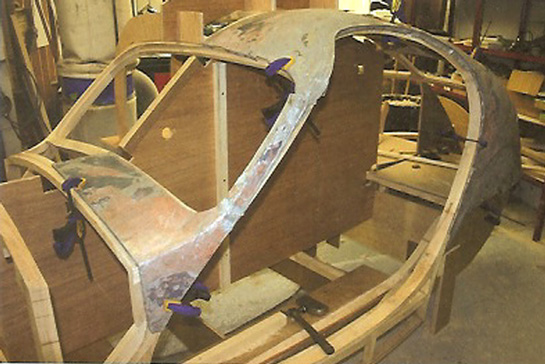
Every piece of the original body that could be used was placed around a new ash frame. Credit: Paul Russell
In 1965, Paul André Berson, who found the car and knew what it was, took possession. He began a long restoration, stripping many damaged parts from the car and finding replacements or having them made. In 1977, the restoration completed, Berson sold the car to well-known collector, Nicholas Seydoux. Seydoux later had André Lecoq re-restore the car.
Meanwhile, Berson had retained the dashboard, trim pieces, the engine block and various other parts that he had removed from the T57S and began to construct a replica based on them. Thankfully, the present owner bought both the Seydoux car and the replica package and the various parts were reunited at Paul Russell and Company in Essex, Massachusetts.
Russell and the owner made the decision to restore the car to its post-Figoni and Falaschi configuration, using as many original parts and panels as possible. The workmanship Paul has exhibited on this project shows why he has such a stellar record at Pebble – two Best of Shows, five class wins, Most Elegant Sports Car (twice), Most Elegant Convertible, and the coveted FIVA Award.
The dashboard recovered from Berson offered valuable clues, including the leatherette covering, allowing the interior to be returned to its original color. The original instrument cluster also assisted accuracy as the dash in the Seydoux car had a wood fascia as on a factory-bodied Atlantic.
The Bugatti 57S will be entered for display only, as its complicated history does not allow it to fit into the existing Pebble Beach judging system. The Pebble Beach organizers are to be complimented for recognizing the importance of this automotive artifact and allowing the public to see the results of this serious attempt to preserve as much of the Bugatti’s continuous history as possible.
VeloceToday will feature a further piece on this car the Thursday after the Monterey Automobile Festival week. It will include pictures of the car on the show field at the Pebble Beach Concours d’Elegance.
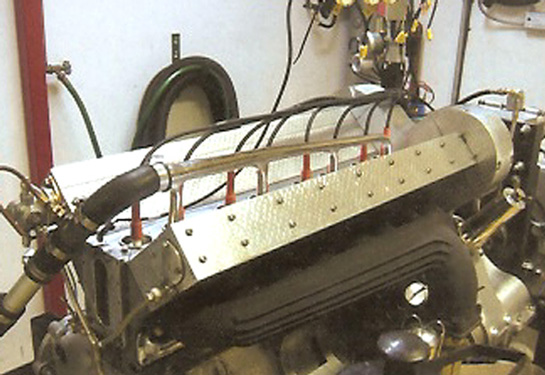
I saw the car three weeks ago at Paul Russell’s shop as it was being finished and it is spectacular.
Hi Alan, thanks for the comment. Hopefully we’ll see more of Paul’s work coming up.
Mike, Nice and to the point. I’ve always held that if I were fortunate enough to have any old car this one would be at the top of my list. By age of course. Here is my top four.
1935-36 T57 Atlantic, Alfa 8C 2900MM or B, M-B 300SLR (W196S) #722 and a Ferrari 250GTO (4293).
And RL has three of the four.
Alan Boe’s comment above brought back some memories for me: I saw RL’s T57 in the final stages of restoration at Paul Russell’s shop in 1989! I’d driven from western MA to Essex with a good friend to pick up his recently-serviced ’57 Gullwing (with but 20k original miles on it, I might add). There was plenty of eye candy in the shop, but the T57 definitely stole the show–it was pretty obvious even then that it’d be hard to top it at Pebble. I missed the PBC in ’90, so glad I got to see it before hand. Even then, though, I recall that the standard shop rate was $75/hr, but panel work was $150/hr. I can only imagine what it costs today to restore one of these cars–no doubt worth it in this case!
Article of this car by Paul Russell “Restoring History: My Insights on Resurrecting a Bugatti Atlantic” :
http://www.paulrussell.com/articles/RestoringHistory.pdf
Another excellent report by Mike. Like Alan, Chuck and the others, the T57 Atlantic is right at the top of my list of all-time great cars. Putting that aside, we are pleased to have had both the first and fourth cars on the lawn at Pebble Beach where both went on to win Best of Show.
The resurrection of the third car is without question a heroic effort on the part of the owner. And none are better equipped to do it than Paul Russell who is also one of my longtime senior judges.
We focus on originality in our class judging and the car will be presented for display only. However, suffice to say, we expect to see a spectacular car arrive in the early morning dew and majestically glide to its place on the lawn.
Read your article with interest. The job performed by the Paul Russell team is absolutely marvelous but why call this a restoration? Apart from a few panel parts on the the left side of the body all is new or parts from other Bugatti cars. It would be much more correct to call this a recreation or reproduction. The chassis is new, the ash frame is new, and you are not even sure that it has exactly the same dimensions as the original car. The engine/gearbox, front and rear axles came from a standard T57 and the dry sump was manufactured by Berson when he built his first version. The story about the dash and the seats is pure fantasy as the whole interior was changed long before Chatard purchased the car so how come to the conclusion that it were original items just because the were found at the scrapyard. It is sad that the more valuable these cars become the more stories are being invented to make them more real than real.
Vive la Marque, Erik Koux.
There is really only one noted “Atlantic” historian and that is Erik Koux. Not only with great knowledge but also not scared to tell the story.
Surprisingly ( well may not ) nobody ever asked him his opinion on the “recreation” of this automobile. For the sake of history and to keep everyone honest this would however be a good idea.
Jack Braam Ruben
Michael has again presented a fascinating history of an “automotive artifact” that we might otherwise have nothing more than scant knowledge of without his efforts to unveil the details and anecdotal flavor associated with the subject car, in this case Bugatti T57S chassis number 57473.
His telling of it made my mind wander to another Bugatti with a peculiar past, the T57C Drophead that had a presence in my own life, the Bug my father purchased from Roger Barlow in 1946 after Barlow drove it to California from the east coast where it spent the war years on a farm populated by picky chickens that very much preferred its swank interior for their roosting place. There is much history about that Worlds Fair show chassis number 57733; it became an Edgar family daily driver for the next decade and was the car I learned drive in, RHD, crash box, and clutch pedal tension fit an elephant. Its gears sang and exhaust howled and tach ticked, and made us feel like flying an open cockpit through the Hollywood Hills, along the Sunset Strip, up PCH, and through the orange groves to and from Palm Springs. What joy Bugattis bring, at any price. My father had paid $2000 cash and a wheezy ’41 Caddy convertible for it. When through with 57733 in 1954, he sold it to a Los Angeles nurse for the grand sum of $2,921. It was later crashed and parted out to help complete three other Bugs, I’ve been told. Bugattis are long-lived, for certain.
I am always suspicious when someone is heralded as THE expert on any given subject. The supposed American expert on 1930s French cars has laughable errors in his books. I believe Julius Kruta and Pierre-Yves Laugier know a bit about Type 57s. Accurate history is a team sport, and each generation builds on the knowledge of the last.
Regarding the dash in the Chatard car, the point was that what remained was the residual of the Figoni restyling and therefore, informative of the car’s specification when it was hit by the train.
The Figoni et Falaschi modifications to the rear of this car were very detrimental to its appearance. Why not restore it to the way it looked when it left the factory, with the wrap-around rear fenders like the others? And there were THREE other Atlantics after the Aerolithe: 57374, 57453, and 57591.
My point of view is nearly the same as Erik’s. In the early 1990’s I had a “measuring-session” with the “Seydoux”-car, the notations of which indicated that the efforts of P.-A. Berson had been a reconstruction with considerable faults and imperfections rather than a restauration. The faults relate, apart from an obviously too short chassis frame, to wrong positions of the door-hinges and wrong front- and rearaxle positions as well. The results of my investigations show clearly that the proportion-pattern of the reconstructed car didn’t fit neither the fotos of the car previous to the accident nor a mathematical proportion-system Jean Bugatti seemed to use in developing cars.
Nevertheless, the attempts of P.-A. Berson to reconstruct the crashed car with the damaged residual parts were undoubtedly honorable, although the final result was not really perfect.
This background in mind soon after the “measuring-session” my very first ideas were to re-reconstruct the “Seydoux”-car to its original conditions previous to the accident. So I started extensive investigations, photogrammetric investigations included. I’m really curious about wether or not Paul Russel’s crew did this job I’d anticipated within the about last 20 years!
With no disrespect whatsoever to Paul Russel’s team, I have to agree with Erik Koux and I am glad he said it first. To me this car is a marvellously executed re-creation using some original parts. It really doesn’t deserve to command the same level of respect or monetary value as the other Atlantics, in my opinion (and those Atlantics have been messed with a lot too!). Considering that the most salient feature of this car is the body design and construction, and that body is completely modern fabrication, I’d say it’s no better than a re-creation. That doesn’t mean that it doesn’t make my heart skip a beat when I see it! I just people would call a spade a spade and not call this a restoration.
Many new and very interesting informations about # 57473 have been recently discovered by Christian Huet in France: brand new photos, magazines, papers from owners and french administration, etc
Indeed, many original parts were still in existence…
Paul Russel has been working with these informations.
Probably, we will found wery soon articles in the press.
We can of course go on forever about the recreation of this Automobile.
Erik Koux produced his first alloy “Atlantic” for me some 20 year’s ago now ( using mostly Molsheim parts excl.Chassis/Body/Radiator/Sump/oiltank/Supercharger/steeringwheel ) ,as I could not live without one after I failt to convince my father to buy me EXK6 from Barrie Price.( Ooh,the bitter fights we had the rest of our lifes )
When I proudly showed my “wannebee” on the stand at Retromobile Marc Nicolose commented that it was “nicely made”. And that’s just what Russsel did for his client Mr.Gonzales.No more,no less. After Pebble Beach we Bugattisti celebrated 50 year’s of American Bugatti Club at the Peter Mullin Museum.The Rothschild/Oliver/Williamson Atlantic # 57374 stood proudly on the turntable looking down on us.
One of two.Nore more,no less.Number three is no longer with us. Atlantic # 57473 est mort,Vive Atlantic # 57473. Vive La Marque,La Marque parmi les Marques.Jack Braam Ruben.
Lest my previous entry be misunderstood, there were four Atlantics built after the Aerolithe as Erik Koux says :
first, 57374, the Lord Victor Rothschild//// Dr. Peter Williamson car, now at the Mullin Collection;
then, the “lost” Atlantic, 57453 -54, seen in photos with Mrs. William Grover Williams and her Scottish Terriers — her husband was a factory driver and demonstrator and had frequent use of the car;
third, 57473 the one under disdussion here, which now is a beautifully realized recreation made to mimic its appearance at the time of the 1955 crash that demolished it, instantly killing both the owner, a Mr. Chatard, and his passenger;
and, finally, the Pope//// Lauren car, 57591.
Both 57453 and 57473 were originally painted black, surely at least a small part of the confusion about the number of Atlantics made, and mitigating, in my view at least, Mr. Lauren’s choice to paint his black, since he apparently likes black cars. If whoever owns it next wants to return it to its original sapphire blue, obviously they can do so.
They are restoring one of these Bugatti’s at The Guild restoration shop in Bradford Ontario Canada
Sirs,
Counting the Aerolithe, there were five, not four. The chassis numbers of the four Atlantics: 57374, the Rothschild/ Williamson car, now at the Mullin Museum; 57453, the first black one, hidden early in WWII and never found; 57473 the second black one, demolished by a railcar near Gien, France in 1951 and recently re-created as your article points out; 57591, the Pope/Lauren car. The information about the four Atlantics and the Aerolithe, essentially a prototype for the Atlantics, has been known for several years now. A very accurate Aerolithe replica has recently been built in Canada.
I am exhausted, but content and soon it will be lunchtime. My morning started with an espresso and the Wall Street Journal – the hard copy delivered to my door – and once done with, I went to Bring a Trailer… how I love the editorializing there. Today it was over a Lancia Flavia sedan. And then Veloce Today. First I’m into friend Michael’s Bugatti piece and then I am onto the “replies”. This is heaven sent. Thank you all.
Well, your the one who helped start it all with the Abarth Buyer’s Guide! Which btw is still selling well. So glad to read that you are still there and enjoy what we are dong!
Pete
Hi Michael, Nice article on the line of very limited cars produced – exact number to be determined as usual from the ‘original’ vs ‘non-original’ opinions covering the real original TP/RL car to an apparent new recreation in Canada. When all the dust settles from the commentaries, it would be interesting for the archives to simply compile all the raw facts on all the ‘known’ cars without emotion leaving aside the definition of original for the linguists.
Robert Blair, San Jose, CA.